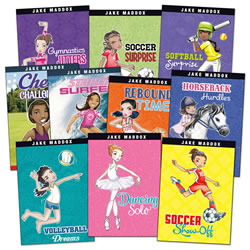What are the rest of the students doing while your pulling small groups?
Independent Reading: Books and More Books: How can I help students find books that fit unit of study that will keep them engaged while I pull groups?
First, we talk about their reading identity for that genre and create a chart in their journals. Second, we discuss the class library, next the difference between real and fake reading The last lesson I do is based on observation and taking note of disengaged students, Each of these lessons are taught on separate days. I usually have book baskets set up on desk that students read from until I have taught all the mini lessons to get Readings Workshop set up are taught, especially the ones related to independent reading. After this, I start book recommendations. I use their identity list and my observations.
I often found I had boys that just couldn't get pass the graphic novels and sports illustrated books or girls from reading the same books over and over. So I began a search of books to give them other options . At this point, we talked about finding books that fit genre of study that they could apply skills and strategies toward.
I needed the students to find books that had strong characters that changed from beginning to middle to end. The unit on Character Development is one of our longest units, and we explore internal and external characteristic of characters and develop theories about them, In order to get my students to be able to apply skills taught in the unit, I had to find books that would peak their interest enough that they would want to explore the character in depth.
Here is a list of the most popular books that I've read and recommended to my students that got them motivated to get out of their comfort zones and be able to analyze how characters develop through the stories they read.
I first suggested authors that I like or found interesting. I gave book blurbs about them and set up book baskets for each. The authors I suggested were: Katherine Patterson, Lois Lowery, Gary Paulsen, Jerry Spinelli, Gordon Korman, Beverly Cleary, and Margaret Haddix. I also find authors for my low readers. I introduced David Adler and Jake Maddox and Mary Osborne,
Jake Maddox was the most popular, He writes stories based around sports. The characters are engaged in some type of sporting event. There are some geared toward boys and girls. Once I introduced them, I noticed the kids sharing them and wanting to go exchange them quicker than they were before being introduced to him. Ellray Jakes was another book that my boys loved. It is also a series book about the every day shenanigans of a little boy.
Then I looked for books with strong characters. The character Stink was the first character I introduced to my class, Oh boy, did they laugh as I read aloud how a young kid was able to get free stuff just by writing a letter. These books are about a little boy that always has something up his sleeve. I loved reading them, The kids loved reading them.
.
I then focused on my girls and found several books that they began to explore and want more like them, For instance these characters, Mallory, Ivy Bean and Kylie Jean and Claudine. All of these characters have a string of books where they go through every day life with twist and turns.
Series are my favorite to introduce to kids because it provides many titles focused around the character that keeps students reading. I share the series that I have read. I created a book recommendation wall where every week students are encourage recommend books to their peers using the form provided. I print a copy of the cover and we post the form with the book cover on the board. You will be amazed how engaged they become. I make sure to model how to write a blurb that will draw readers attention using the turning point. Of course, without giving the story away.
My ultimate goal however is to ignite a passion for Reading in everyone. So I share books I've read, adult and children. My students can see my passion and excitement, and it grabs their attention. My hope with this post is to share some book title that I introduced to my students that helped with my unit on Character Development, but also to share some great book title to draw in your reluctant and unmotivated readers. So now everybody has a book or available book choices, What;s up next? How to plan effective instruction using learning progressions and Reading Bands.
Stay tuned.
Here is an image of the form I use. I searched the Internet and found several. However, I liked the simplicity of this particular form.









